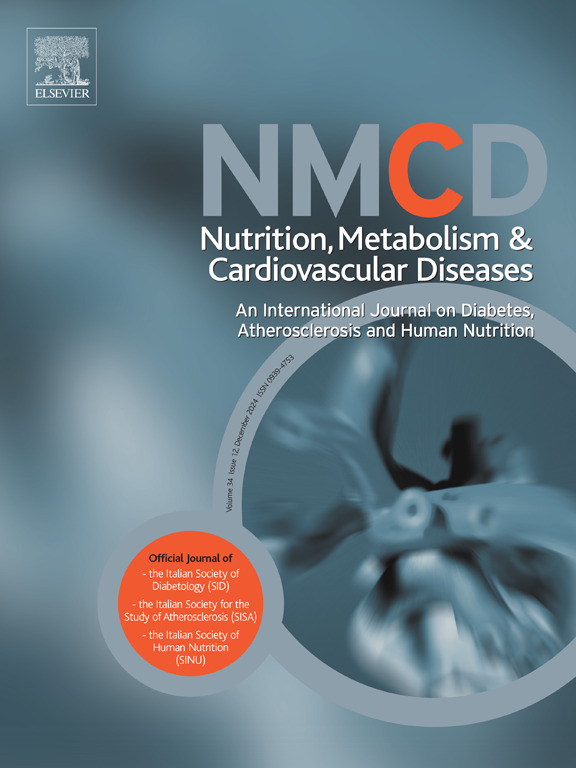高血压、肥胖和2型糖尿病对腔隙性卒中的影响:一项孟德尔网络随机研究。
IF 3.3
3区 医学
Q2 CARDIAC & CARDIOVASCULAR SYSTEMS
Nutrition Metabolism and Cardiovascular Diseases
Pub Date : 2025-03-13
DOI:10.1016/j.numecd.2025.103974
引用次数: 0
摘要
背景和目的:先前的研究报道了腔隙性卒中与高血压、肥胖和2型糖尿病(T2D)的关联。本研究的目的是探讨两者之间是否存在因果关系,以及体重指数是否介导了高血压对腔隙性脑卒中的影响。方法和结果:采用多变量孟德尔随机化(MVMR)和网络孟德尔随机化(NMR)与逆方差加权(IVW)评估高血压、肥胖和T2D与腔隙性卒中的独立性和因果关系。灵敏度分析包括MR-Egger、Cochrane’s Q检验、孟德尔随机化多效性残差和离群值(MR-PRESSO)和leave-one-out,提高了结果的可靠性。MVMR分析发现,遗传预测的高血压使腔隙性卒中风险增加42% (OR: 1.42, 95% CI: 1.29-1.56, P)。结论:该遗传关联研究发现高血压和T2D与腔隙性卒中高风险之间存在新的独立遗传关联,而肥胖可降低腔隙性卒中的风险。研究结果强调了个体化腔隙性卒中预防策略的重要性,而不是统一的体重管理优化高危人群的医疗保健。本文章由计算机程序翻译,如有差异,请以英文原文为准。
The effect of hypertension, obesity, and type 2 diabetes on lacunar stroke: A network Mendelian randomization study
Background and aims
Previous studies have reported an association of lacunar stroke with hypertension, obesity, and type 2 diabetes (T2D). The aim of this study was to investigate whether the association was causal and whether body mass index mediated the effect of hypertension on lacunar stroke.
Methods and results
The independence and causal association of hypertension, obesity, and T2D with lacunar stroke were assessed by multivariate Mendelian randomization (MVMR) and network Mendelian randomization (NMR) with inverse variance weighting (IVW). The reliability of the results was increased by sensitivity analyses including MR-Egger, Cochrane's Q test, Mendelian Randomization Pleiotropy RESidual Sum and Outlier (MR-PRESSO), and leave-one-out. MVMR analysis found that genetically predicted hypertension had a 42 % higher lacunar stroke risk (OR: 1.42, 95 % CI: 1.29–1.56, P < 0.001) when adjusted for obesity and T2D, genetically predicted T2D had a 9 % higher lacunar stroke risk (OR: 1.09, 95 % CI: 1.03–1.16, P < 0.004) when adjusted for hypertension and obesity, and genetically predicted obesity had a 15 % lower lacunar stroke risk (OR: 0.85, 95 % CI: 0.77–0.93, P < 0.001) when adjusted for hypertension and T2D. NMR found that 44 % of the association between hypertension and lacunar stroke risk was mediated by obesity.
Conclusion
This genetic association study found novel independent genetic associations between hypertension and T2D with high risk of lacunar stroke, whereas obesity attenuated the risk of lacunar stroke. The findings emphasize the importance of individualized lacunar stroke prevention strategies rather than uniform weight management optimize medical care in high-risk populations.
求助全文
通过发布文献求助,成功后即可免费获取论文全文。
去求助
来源期刊
CiteScore
6.80
自引率
2.60%
发文量
332
审稿时长
57 days
期刊介绍:
Nutrition, Metabolism & Cardiovascular Diseases is a forum designed to focus on the powerful interplay between nutritional and metabolic alterations, and cardiovascular disorders. It aims to be a highly qualified tool to help refine strategies against the nutrition-related epidemics of metabolic and cardiovascular diseases. By presenting original clinical and experimental findings, it introduces readers and authors into a rapidly developing area of clinical and preventive medicine, including also vascular biology. Of particular concern are the origins, the mechanisms and the means to prevent and control diabetes, atherosclerosis, hypertension, and other nutrition-related diseases.

 求助内容:
求助内容: 应助结果提醒方式:
应助结果提醒方式:


